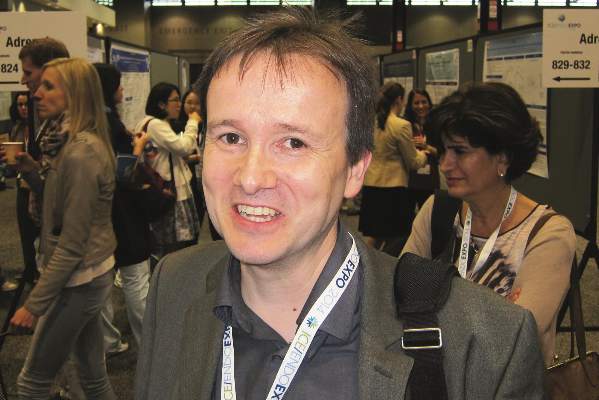User login
CHICAGO – Growth hormone therapy appears to protect against fractures in adults with growth hormone deficiency and no history of osteoporosis, according to an analysis from the HypoCCS study.
In contrast, growth hormone (GH)-deficient patients with preexisting osteoporosis are another story. GH replacement didn’t affect fracture risk in that subgroup of participants in HypoCCS (the Hypopituitary Control and Complications Study), Christopher J. Child, Ph.D., reported at the joint meeting of the International Congress of Endocrinology and the Endocrine Society. It’s well established that GH-deficient adults have lower bone mass and a two- to fivefold increased risk of fractures, compared with controls. Moreover, GH replacement therapy has been shown to increase bone-mineral density and bone-mass density and produce salutary effects on bone turnover markers.
But HypoCCS is the first prospective controlled study to suggest long-term GH therapy actually prevents fractures in adults with GH deficiency, noted Dr. Child of Lilly Research Laboratories in Windlesham, England.
He presented a retrospective analysis of prospectively collected data from the observational study, which included 8,374 GH-treated adults and 1,267 untreated controls, all with GH deficiency alone or in combination with other pituitary hormone deficiencies.
During a mean follow-up of 4.6 years in the GH-treated group, the combined incidence of vertebral and nonvertebral fractures was 11.9/1,000 person-years, compared with 19.1/1,000 person-years in controls, for a 37% relative risk reduction. The risk of vertebral fractures was 45% lower in the GH-treated patients; nonvertebral fractures were decreased by 32%.
In a multivariate Cox proportionate regression analysis, the protective effect of GH replacement therapy remained significant after adjustment for the common fracture risk factors, including age greater than 60 years, female gender, depression, the use of corticosteroids, and increased body weight. Dr. Child stressed in an interview that physicians shouldn’t take these HypoCCS findings as the final word on the issue of whether growth hormone replacement prevents fractures in GH-deficient adults. While this is the first-ever analysis of fracture risk from a long-term adult GH replacement study, as in any nonrandomized observational study selection bias is a possibility. And data were lacking on several potentially important confounding factors, including participants’ alcohol and calcium intake, as well as their level of physical activity.
Still, he said, the notion that GH replacement therapy may have a reduction in fracture risk as a side benefit is attractive.
He is an employee of Eli Lilly, which funds HypoCCS.
CHICAGO – Growth hormone therapy appears to protect against fractures in adults with growth hormone deficiency and no history of osteoporosis, according to an analysis from the HypoCCS study.
In contrast, growth hormone (GH)-deficient patients with preexisting osteoporosis are another story. GH replacement didn’t affect fracture risk in that subgroup of participants in HypoCCS (the Hypopituitary Control and Complications Study), Christopher J. Child, Ph.D., reported at the joint meeting of the International Congress of Endocrinology and the Endocrine Society. It’s well established that GH-deficient adults have lower bone mass and a two- to fivefold increased risk of fractures, compared with controls. Moreover, GH replacement therapy has been shown to increase bone-mineral density and bone-mass density and produce salutary effects on bone turnover markers.
But HypoCCS is the first prospective controlled study to suggest long-term GH therapy actually prevents fractures in adults with GH deficiency, noted Dr. Child of Lilly Research Laboratories in Windlesham, England.
He presented a retrospective analysis of prospectively collected data from the observational study, which included 8,374 GH-treated adults and 1,267 untreated controls, all with GH deficiency alone or in combination with other pituitary hormone deficiencies.
During a mean follow-up of 4.6 years in the GH-treated group, the combined incidence of vertebral and nonvertebral fractures was 11.9/1,000 person-years, compared with 19.1/1,000 person-years in controls, for a 37% relative risk reduction. The risk of vertebral fractures was 45% lower in the GH-treated patients; nonvertebral fractures were decreased by 32%.
In a multivariate Cox proportionate regression analysis, the protective effect of GH replacement therapy remained significant after adjustment for the common fracture risk factors, including age greater than 60 years, female gender, depression, the use of corticosteroids, and increased body weight. Dr. Child stressed in an interview that physicians shouldn’t take these HypoCCS findings as the final word on the issue of whether growth hormone replacement prevents fractures in GH-deficient adults. While this is the first-ever analysis of fracture risk from a long-term adult GH replacement study, as in any nonrandomized observational study selection bias is a possibility. And data were lacking on several potentially important confounding factors, including participants’ alcohol and calcium intake, as well as their level of physical activity.
Still, he said, the notion that GH replacement therapy may have a reduction in fracture risk as a side benefit is attractive.
He is an employee of Eli Lilly, which funds HypoCCS.
CHICAGO – Growth hormone therapy appears to protect against fractures in adults with growth hormone deficiency and no history of osteoporosis, according to an analysis from the HypoCCS study.
In contrast, growth hormone (GH)-deficient patients with preexisting osteoporosis are another story. GH replacement didn’t affect fracture risk in that subgroup of participants in HypoCCS (the Hypopituitary Control and Complications Study), Christopher J. Child, Ph.D., reported at the joint meeting of the International Congress of Endocrinology and the Endocrine Society. It’s well established that GH-deficient adults have lower bone mass and a two- to fivefold increased risk of fractures, compared with controls. Moreover, GH replacement therapy has been shown to increase bone-mineral density and bone-mass density and produce salutary effects on bone turnover markers.
But HypoCCS is the first prospective controlled study to suggest long-term GH therapy actually prevents fractures in adults with GH deficiency, noted Dr. Child of Lilly Research Laboratories in Windlesham, England.
He presented a retrospective analysis of prospectively collected data from the observational study, which included 8,374 GH-treated adults and 1,267 untreated controls, all with GH deficiency alone or in combination with other pituitary hormone deficiencies.
During a mean follow-up of 4.6 years in the GH-treated group, the combined incidence of vertebral and nonvertebral fractures was 11.9/1,000 person-years, compared with 19.1/1,000 person-years in controls, for a 37% relative risk reduction. The risk of vertebral fractures was 45% lower in the GH-treated patients; nonvertebral fractures were decreased by 32%.
In a multivariate Cox proportionate regression analysis, the protective effect of GH replacement therapy remained significant after adjustment for the common fracture risk factors, including age greater than 60 years, female gender, depression, the use of corticosteroids, and increased body weight. Dr. Child stressed in an interview that physicians shouldn’t take these HypoCCS findings as the final word on the issue of whether growth hormone replacement prevents fractures in GH-deficient adults. While this is the first-ever analysis of fracture risk from a long-term adult GH replacement study, as in any nonrandomized observational study selection bias is a possibility. And data were lacking on several potentially important confounding factors, including participants’ alcohol and calcium intake, as well as their level of physical activity.
Still, he said, the notion that GH replacement therapy may have a reduction in fracture risk as a side benefit is attractive.
He is an employee of Eli Lilly, which funds HypoCCS.
AT ICE/ENDO 2014
Key clinical point: Growth hormone replacement therapy in adults with GH deficiency may have an appealing side benefit: reduced fracture risk.
Major finding: In a multivariate analysis, adults on GH replacement therapy for GH deficiency had an adjusted 31% reduction in fracture risk compared to untreated controls.
Data source: A retrospective analysis of the prospective, observational HypoCCS study involving 8,374 GH-treated adults and 1,267 untreated controls, all with GH deficiency.
Disclosures: The HypoCCS study is funded by Eli Lilly. The presenter is a company employee.

